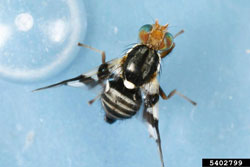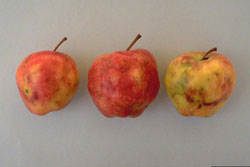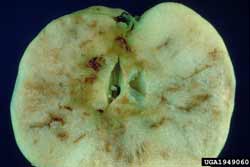Apple Maggot—Rhagoletis pomonella
Apple maggots cause two types of injury: "dimpling," and tunneling. Dimpling occurs around the site where eggs are laid, causing the flesh to stop growing, resulting in a sunken, misshapen, dimpled area. Tunneling, done by the larvae (maggots) eating in the fruit, causes the pulp to break down, discolor, and start to rot. The tunnels are often enlarged by bacterial decay. Damaged fruit eventually becomes soft and rotten and cannot be used.

The apple maggot fly is about l/4-3/8 inches long. It has a black abdomen. Females have four white bands on the abdomen. The smaller males have three bands. The wings are clear but are marked with black bands.
Click on images to view full-size
Identification and Control Information
- Fact Sheet: Apple Maggot (PDF)—Cornell University Insect Diagnostic Laboratory
- Apple Maggot: Scourge of Home Apple Production (PDF)—University of Wisconsin
[Photos, left to right: Joseph Berger, Bugwood.org; H.J. Larsen, Bugwood.org; E.H. Glass, New York State Agricultural Experiment Station, Bugwood.org]

